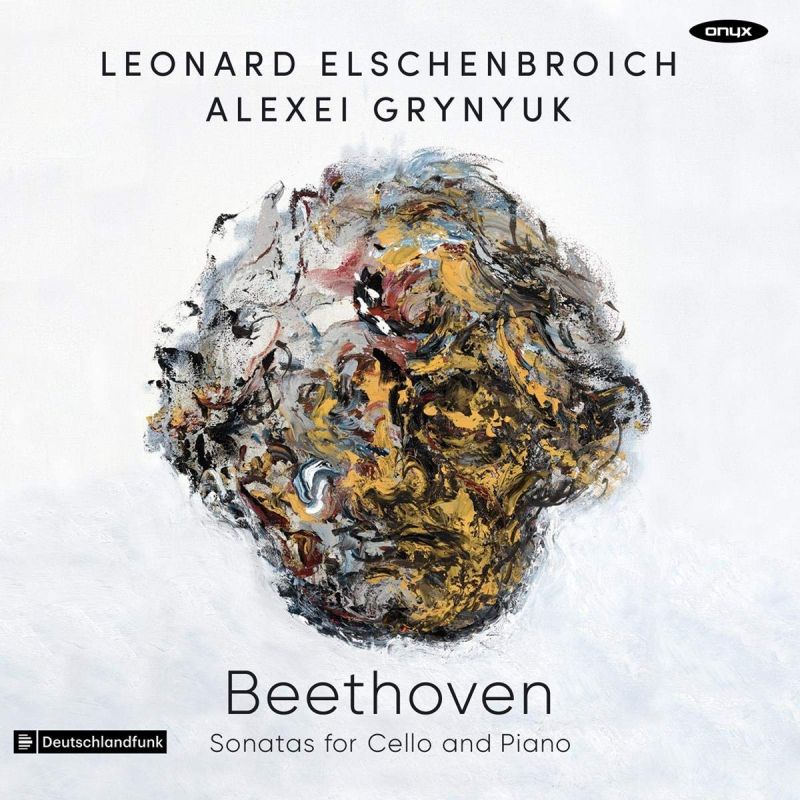BEETHOVEN 5 Cello Sonatas (Leonard Elschenbroich)
View record and artist detailsRecord and Artist Details
Composer or Director: Ludwig van Beethoven
Genre:
Chamber
Label: Onyx
Magazine Review Date: 06/2019
Media Format: CD or Download
Media Runtime: 126
Mastering:
DDD
Catalogue Number: ONYX4196

Tracks:
| Composition | Artist Credit |
|---|---|
| Sonata for Cello and Piano No. 1 |
Ludwig van Beethoven, Composer
Alexei Grynyuk, Piano Leonard Elschenbroich, Cello Ludwig van Beethoven, Composer |
| Sonata for Cello and Piano No. 2 |
Ludwig van Beethoven, Composer
Alexei Grynyuk, Piano Leonard Elschenbroich, Cello Ludwig van Beethoven, Composer |
| Sonata for Cello and Piano No. 3 |
Ludwig van Beethoven, Composer
Alexei Grynyuk, Piano Leonard Elschenbroich, Cello Ludwig van Beethoven, Composer |
| Sonata for Cello and Piano No. 4 |
Ludwig van Beethoven, Composer
Alexei Grynyuk, Piano Leonard Elschenbroich, Cello Ludwig van Beethoven, Composer |
| Sonata for Cello and Piano No. 5 |
Ludwig van Beethoven, Composer
Alexei Grynyuk, Piano Leonard Elschenbroich, Cello Ludwig van Beethoven, Composer |
| Sonata for Horn and Piano |
Ludwig van Beethoven, Composer
Alexei Grynyuk, Piano Leonard Elschenbroich, Cello Ludwig van Beethoven, Composer |
Author: Andrew Farach-Colton
In Leonard Elschenbroich and Alexei Grynyuk’s hands, these sonatas’ staggering invention is impossible to ignore. The musicians’ success comes, at least in part, from scrupulous attention to the composer’s markings in matters of dynamics and articulation. Listen to the expectant hush with which they play the beginning of Op 5 No 1 – and note, too, how Elschenbroich sneaks into a crescendo so it seems to come out of nowhere. Or turn to the opening Andante of Op 102 No 1, rendered with such rapt yearning that it sounds as if it’s being dreamily improvised.
Dynamic contrasts are starkly defined throughout, further sharpening musical characterisations. They wring every last ounce of drama from the central Allegro molto of Op 5 No 2, for example, and although they play both repeats, there’s no slackening of tension or feeling of protraction. I was particularly riveted by the cellist’s fervid phrasing in the repeat of the development section (at 9'05"), where he digs in even deeper than the first time around. His sound isn’t especially plummy – there’s a slight (and, I think, endearing) nasal quality to it – but his legato is seamless and he’s not shy about roughing up his tone when called for, as in the two Trios of Op 69’s Scherzo.
Indeed, Elschenbroich and Grynyuk find a wealth of textural variety in these sonatas. Grynyuk’s touch can be astonishingly delicate and is unfailingly articulate. I love the rhythmic buoyancy both musicians bring to the rondos of Op 5 No 2 and Op 69 – whose ebullience borders on the giddy – and by Op 102 No 2’s concluding Allegro fugato, where they step lightly and with unfailing grace through exceptionally intricate polyphony.
They can drive the music hard in fast movements, although their playing always breathes naturally. In a few places, I feel the breaths between thematic sections are held a hair too long. And in the slender slow introduction to Op 69’s finale their phrasing feels a bit fussy when heard alongside, say, Rostropovich and Richter (Philips, 4/95).
Unlike many other recordings of the complete sonatas, Elschenbroich and Grynyuk eschew the sets of variations, offering instead a delightful account of the Horn Sonata in an arrangement likely made by the composer himself. The balance between the instruments ever so slightly favours the piano, and in some forte passages I wish the cello had greater presence. But this is a very minor complaint in the face of such superb music-making.
Discover the world's largest classical music catalogue with Presto Music.

Gramophone Digital Club
- Digital Edition
- Digital Archive
- Reviews Database
- Full website access
From £8.75 / month
Subscribe
Gramophone Full Club
- Print Edition
- Digital Edition
- Digital Archive
- Reviews Database
- Full website access
From £11.00 / month
Subscribe
If you are a library, university or other organisation that would be interested in an institutional subscription to Gramophone please click here for further information.




